Understanding Buck Movement: How, When, and Why Bucks Navigate the Landscape
Why Move?
Everyone makes regular movement decisions to find and access resources necessary for their survival and well-being: food, shelter, and interaction with others. These regular movements collectively form a pattern that we call an individual’s movement behavior. If your smartphone “dropped a pin” every 15 minutes to mark your location on a map, you would see some broad patterns related to your movement. There would be clusters of points where you spend the most time—for example, at your home, work, and maybe church or a recreational area. Other points would be spread out along travel lanes to places we visit occasionally, but as “creatures of habit,” we tend to exhibit similar movement behavior until something stimulates a change.
The human brain has a high capacity for complex reasoning, but a white-tailed deer brain is “wired” for enhanced sensory perception. However, deer move for essentially the same reasons we do: to safely find food, water, and shelter (see Thinking Like a Deer). Most deer behavioral decisions are driven by physiological processes related to survival, hunger, and reproduction, and are influenced by food availability and cover.

A deer’s food resources are not evenly distributed across the landscape and change over time, so meeting nutritional needs is the primary driver of deer movement most of the year. Deer must figure out where the best foods are located and choose a path to and from those food resources that keeps them safe from predators, both natural and human.
Breeding is an important natural process that drives the movement decisions of adult bucks during breeding season (i.e., the rut). A buck is sexually capable from velvet shedding until shortly after antler drop, but his decisions are influenced most after females within the area start coming into estrus and are receptive to breeding. Their movement behaviors are motivated by their need to find and breed receptive does. The typical cautious nature of older bucks becomes a secondary consideration while pursuing a doe in or near estrus.
In addition to movements within a single area, some deer also undertake pronounced seasonal migrations that optimize their use of fluctuating resources. One of the most famous examples of seasonal migration is seen on the Serengeti Plains in Africa, where millions of wildebeests, zebras, and antelope migrate to take advantage of regional patterns of changing rainfall, food, and water resources. Some populations of white-tailed deer exhibit migratory behaviors to access resources necessary for their survival but on a much smaller scale. Populations of deer in northern states migrate to “deer yards” seeking thermal cover and protection from harsh winter weather. Deer in the southern latitudes generally do not need to migrate to survive, thanks to mild winters. However, we do see some extreme movement distances that resemble migration.
Deer may also venture outside their normal area searching for new sources of food or breeding opportunities. These short-term movements outside this area are called excursions. People also go on excursions, but we call them vacations or trips. Vacations are analogous to excursions because we leave home for a short time to visit and explore some place before returning home. Deer excursions can last a day or several days and span several miles. Excursion events happen more often during the breeding season, so some of these movements are likely tied to mate-search behavior. That said, excursions also take place during the spring and summer, so not all excursions are related to breeding.
Unlike seasonal migrations and excursions that conclude with the deer returning to the original area, dispersal is the permanent movement of deer to a new area. Dispersal is most often seen in yearling bucks when up to 80 percent leave the mother’s home area. Some young bucks disperse around their first birthday, pushed away by mom during late pregnancy. Another group will disperse at 16–20 months of age, when they start interacting as “adults” with other local, older bucks. Dispersal distance depends on the characteristics of the landscape, with a range of 2 to 20 miles. Distances tend to be less in forested areas and more in open, agriculture-dominated land types with less cover. These dispersal movements are important to the species’ ecology, as they minimize inbreeding within populations and enhance gene flow among populations.
This publication includes Mississippi State University Deer Lab research on buck movement that addresses concerns shared by hunters with the Mississippi Department of Wildlife, Fisheries, and Parks (MDWFP). As the research arm of MDWFP, our cooperative research was designed to show when and how deer move and try to understand the factors that affect their decisions. We answer questions about “disappearing” bucks during the hunting season and how adult bucks use the landscape when hunters are present. We also describe how vegetation types and other landscape characteristics influence buck movement. Understanding these factors will help land managers create habitat that fulfills the needs of deer throughout the year while helping hunters “think like a deer” to improve their odds of success.
Study Area
Conditions of the land and deer population greatly impact food and cover, so we need to describe the location of our work. All landowners within our 50,000-acre study area shared the goal of producing older bucks for recreational harvest, with an adult sex ratio of 1 buck to 1–2 does. Within our study area, hunter harvest was the leading cause of mortality in adult bucks, but other causes included vehicle collision, epizootic hemorrhagic disease (EHD), and poaching. The annual survival rate ranged from 60 to 75 percent.

Figure 1. Study area.
White-tailed deer are flexible in their habitat requirements and can respond rapidly to environmental changes, which allows them not just to survive but thrive in a variety of landscapes. Deer thrive throughout our study area of private landholdings along the Big Black River in Mississippi (Figure 1). Some call it a “deer factory” because the area produces lots of deer and big deer. Our study area included a diversity of vegetation types common in the southeastern United States. Land cover was dominated by two major groups, forest and agriculture, with forest cover being the most abundant. Natural vegetation types were upland deciduous forests, pine plantations, herbaceous vegetation (fields), and bottomland deciduous forests. Bottomland deciduous forests border the Big Black River and cover about 38 percent of the area.
Food supplies are important to deer, and the amount of available forage varies among the vegetation types. There was not a lot of forage available in the upland deciduous forests. Managed pine plantations were commercial loblolly pine stands, in which canopy closure limits forage supply during much of the stand rotation. Forages were abundant in herbaceous areas during spring and summer, but by hunting season, a lot of the forage was dead or of very low quality. The bottomland deciduous forests were mostly mature hardwoods with a good concentration of oaks; but their closed canopy limited forage growth on the ground, so their main food attraction was acorns. Commercial agriculture fields were the second most common vegetation type and covered about 30 percent of the study area, with crops including corn, cotton, and soybeans. All agriculture fields were harvested by the start of hunting season, so they were essentially barren fields with very little, if any, available forage or cover during fall.
Landowners planted food plots on about 1,000 acres (2 percent of the area) to supplement natural forage during winter or summer. Summer food plots were planted with high-quality soybeans or deervetch. Deervetch lasted until the first frost in December, so, in addition to a lot of high-quality forage, the height of the deervetch vegetation provided hiding cover during hunting season. Winter food plots consisted of oats and clover but did not reach a height that supplied cover during the hunting season (Figure 2). Some landowners also used gravity and/or spin feeders. Spin feeders contained corn, while gravity feeders provided full-ration pellets.

Figure 2. Summer and winter food plots.
General Movement Behavior
Although behavioral responses differ among individual deer and between sexes, our large sample of adult bucks allows us to generalize expected patterns of behavior with the understanding that there will be individual deer that behave differently from the norm. The age structure of our buck sample was 11 percent 2.5 years, 30 percent 3.5 years, 25 percent 4.5 years, and 33 percent 5.5-plus years. Female movements will be more constrained than males, but they should respond similarly to external influences and habitat forage quality.
Daily movement rate, the total linear movements in a 24-hour period, shows major changes throughout the fall and winter. Our collars recorded a GPS location every 15 minutes from September 1 to February 28 and every 4 hours from March 1 to August 31. Bucks are always moving, but their daily distance increased from 4,000 yards from October to November to over 6,000 yards from December to January (Figure 3). The average daily movements during February were more comparable to values from September to November. These monthly changes make sense because most breeding activity takes place from mid-December to mid-January and finding receptive does is the motivating force behind buck movements during this time.

The timing of breeding season varies dramatically across Mississippi (and much of the Southeast). In our study area, peak rut, during which 50 percent of does are bred, occurs over 2 weeks from December 25 to January 7. Another 40 percent of breeding is split between the two weeks before peak rut (early rut; 20 percent) and after (late rut; 20 percent). A doe can be in estrus and bred during the pre-rut, but bucks generally spend their time searching and scraping during this period. Post-rut is primarily a period of physical and nutritional recovery for bucks, although some additional breeding will take place as does with unsuccessful first pregnancies recycle and late-developing younger does breed for the first time.
Daily movement rates of adult bucks during the breeding season are focused on the “business of breeding.” Bucks are no longer generally “thinking like a deer”—their behavior is driven by a sharp increase in reproductive hormones so they “think like a buck” (see Thinking Like a Buck During Breeding Season). By early October, a buck’s testosterone (the male hormone) levels are high and impacting his activity and movement decisions. Initially, his actions focus on rubbing and scraping behaviors and testing his place in the buck dominance hierarchy. During each phase of the rut, we see adult bucks move progressively greater daily total distances from pre-rut through early rut to peak rut (Figure 4).

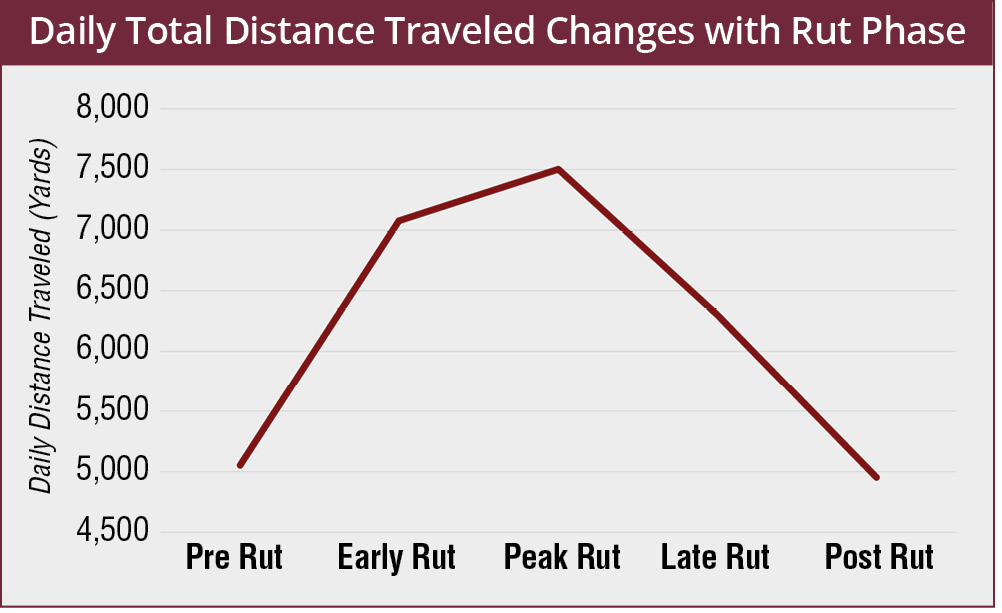
Bucks certainly are not “couch potatoes” during pre-rut, traveling 4,800 yards (2.7 miles) per day, but that’s just their warm-up session. As the number of estrus does increases during early rut, so too do buck movements, increasing to over 7,000 yards per day during early rut. Total daily movements of bucks are greatest during peak rut, when bucks move over 7,500 yards (4 miles) total per day! Buck movements during early rut and peak rut reflect their increased effort to find and breed receptive does. Traveling greater total distances each day helps bucks maximize encounters with estrus does. Movement totals decrease during late rut as the number of estrus females declines and the bucks get physically worn out, finally returning to their “normal” daily total of about 5,000 yards during post-rut.
Hunters (and many deer biologists) claim that moon phase significantly impacts deer movements, based on personal observations. When we break down our total daily movement rates into daytime and nighttime periods, we see results by moon phase that are quite conclusive—just not in the way we may have expected (Figure 5). Total distance traveled throughout the daytime and nighttime hours varies from day to day, with greater total movement during the night than during the day. However, there is absolutely no pattern of variation that can be associated with moon phase.

Daily movement can be further interpreted by comparing the hourly rate of movement during daytime and nighttime periods (Figure 6). Hourly movement rate at night was twice as great as during the day early in the hunting season when temperatures were warmer and deer were “thinking like a deer.” With the onset of the breeding season, hourly movement rates became similar during day and night because our collared deer were “thinking like a buck during the breeding season” and searching for and tending adult females without regard for safety (Figure 7).


Here Today, Not Tomorrow?
We can learn a lot about daily movement behavior by discriminating between “total distance” and “net distance.” Rather than the total of distances between all locations over a 24-hour period, net distance is the distance from where the deer started to where the deer was located 24 hours later (Figure 8). If total distance is large and net distance is very small, then the buck moved around the landscape but returned daily to the same area.
The changes in total distance are expected because adult bucks increase or decrease their daily movements with each phase of the rut. However, we found that net distance measurements also change over time relative to the rut (Figure 9), which means the places where adult bucks start and end each 24-hour period are not the same. In fact, net distance is 1.7 times farther during peak and late phases of the rut than before the rut begins. Movement behavior during one day of the peak rut leads to an adult buck’s ending location being about 1,600 yards (or 0.9 mile) on average away from where it began (Figure 9). Our findings challenge the idea that bucks have one special sanctuary to which they return; instead, they have multiple focal areas that they use during the breeding season.


Focal areas are places on the landscape that deer visit repeatedly. We found that adult bucks revisit many distinct locations with varying levels of regularity throughout the hunting season (Figure 10). We identified these areas based on the movement characteristics of deer and determined areas where they were showing “concentrated movements” (slower movement rates with lots of turning—like our movements at home). We do not know exactly what is holding the buck in the area (most likely resting), but nearly all our adult bucks are showing these repetitive movements, shifting areas frequently—74 percent of them changed focal areas every 6–10 hours. So hunters should expect bucks to use many areas rather than a single “sanctuary.”
Hunters and land managers should recognize that bucks will use multiple focal areas during hunting season. These focal areas can be scattered across a property, so managers can influence buck movement by setting up travel corridors that connect nearby focal areas. Hunters can take advantage of the opportunities present along these travel corridors to see adult bucks during daylight hours.
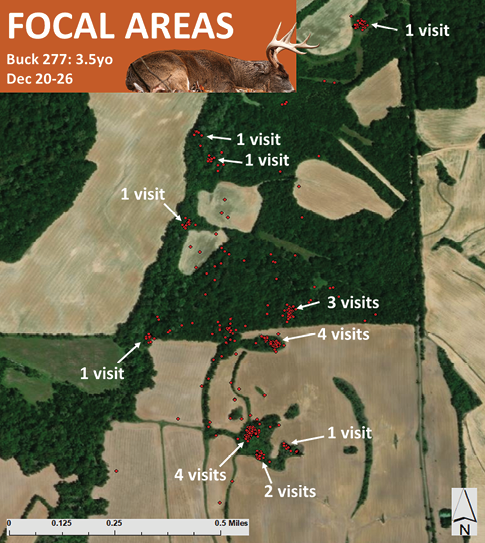
Daily Activities
We know adult bucks travel greater distances and revisit discrete focal areas during the breeding season, so now let’s look at the types of behaviors that make up their daily activities. We categorized buck behavior based on characteristics of their movement, such as turning angle and distance between consecutive locations. Using locations every 15 minutes, we differentiated three movement behaviors: walking, feeding/tending, and bedding (Figure 11). We called movements with long travel distances and minimal turning angles as “walking.” Moderate travel distances with sharper angles we called “feeding” (actively foraging) or “tending” (hanging around an estrus female). The remaining locations with little or no movement we classified as “bedded.” Bucks spend time each day performing all three movement behaviors.

White-tailed deer are crepuscular animals, so we expect to see daily activity peak around dawn and dusk. We see that about 60 percent of the behaviors displayed during twilight hours are feeding/tending or walking movements (Figure 12). This means that adult bucks follow the activity patterns we expected with the most movement during dawn and dusk. Bucks are also bedded most often during daylight hours and least often during dusk and dawn.
Hunters should keep in mind that deer will show a “flurry of activity” at dawn and dusk (i.e., crepuscular movement pattern), but you are still likely to see bucks move throughout the day. So, if your schedule allows, arrive at your stand before sunrise, hunt all day, and stay in your stand until after sunset. If you get out of the stand after 2–3 hours you are probably missing opportunities to see and harvest bucks.
Looking at these behaviors over the hunting season, you can see that adult bucks spend less time bedded and more time moving during the later months of the hunting season compared to the first two months of the season (Figure 13). Adult bucks spend about twice as much time walking during December and January than they do in October and November. This increase in walking behavior and decrease in bedding behavior of adult bucks in December is due to the drive to find and breed receptive does during the rut, and the reason bucks lose so much weight during the rut.
Adult bucks alter their movements and behaviors during the distinct phases of the rut in response to changes in the percentage of females entering estrus. During early rut and peak rut, adult bucks are generally bedded less and walking more, which makes sense given that adult bucks are looking for receptive does to breed (Figure 14). The amount of time an adult buck spends walking each day decreases after the rut, when they spend more time feeding and bedded.
We know that bucks lose a lot of weight during the breeding season because they reduce their food intake in favor of searching for breeding opportunities. It is interesting that the amount of time that bucks spend feeding or tending to receptive does is similar across all phases of the breeding season. Given the similarities between movements related to feeding and movements related to tending does, it was not possible for us to differentiate between these two behavioral states with our data. That said and given what we know about buck behavior during the rut, it is likely that the amount of time the adult bucks spent tending receptive does increased during the rutting periods, relative to the other phases of the breeding season. Moreover, the increase in the amount of time that adult bucks spent in this feeding/tending behavior seen during the post-rut phase of the breeding season is likely due to feeding activities related to post-rut recovery.



Home Range
Movements and behaviors take place within an animal’s home range, with the shape and size of home ranges resulting from decisions about where, when, and how to access food, cover, and water. Daily movements of adult bucks were usually contained within an annual home range of about 860 acres. However, the tremendous amount of variation among individuals makes it difficult to state with certainty what any one buck will do. The median annual home range was about 860 acres, but 27 percent were less than 500 acres and about 25 percent were greater than 2,000 acres (Figure 15).
Deer must move to access the resources they need to survive. The distance a deer must travel to meet its daily needs will be greater for deer living in environments where the required resources are scattered across the landscape. Conversely, we would expect to see smaller home range sizes for deer living in areas where food is more available because deer would not need to move as far to acquire those same resources. To put it simply, home range sizes of deer in poor-quality habitats will be relatively large compared to the home range sizes of deer in higher-quality habitats. For landowners, this means that if you have everything a deer needs on your property, then deer are more likely to stay on your property. Given this generality, note that habitat quality across our 50,000-acre study area was good to excellent during our study.
Home range can be calculated for any time interval or interest, so we included estimates for 24-hour intervals to represent the area over which an adult buck will travel during any given day a hunter is afield and during 2-week intervals associated with the breeding season (Figure 16). The large annual home ranges described above may seem daunting to some hunters, but realize that daily home range isn’t much more than 200 acres even during their most active peak rut period. At first look, you may be surprised to note that late-rut home range is about double that of peak rut. However, it makes sense when you note that, even though total daily movement rate declined from peak to late rut, the net displacement increased, meaning they were farther away from where they started, and thus covered more “home range.”


Buck Personalities (Mobile versus Sedentary)
White-tailed deer, like humans, are individuals, so it would be a mistake to assume all deer move about the landscape in identical ways. Many hunters set up trail cameras before and during the hunting season to locate deer and identify specific bucks and their movement patterns. This is generally to improve the chances of harvesting a particular deer by pinpointing which areas he’s using and when. However, when hunters finally pattern a specific buck, he sometimes vanishes and is never seen again that season. Such cases are understandably frustrating, and while we can’t remove your frustration, we can explain what may have happened. We classified adult bucks into two groups based on movement and home range characteristics, which we refer to as their “personality”—mobile and sedentary. These personalities explain why some bucks patterned by hunters disappear during some or all of the hunting season only to reappear at a later time.
About one-third of our adult bucks were mobile and had a migratory lifestyle with two distinct seasonal home ranges. For example, toward the end of August 2017, Buck 297 traveled to the northwest about 2 miles (or 3,520 yards) to his other home range, which he occupied until late January 2018 (Figure 17). During the last few days of January, Buck 297 made a reverse movement along the same corridor and returned to his southeastern home range and remained there until August 2018, when he again traveled to his northwestern home range just like the year before.
The other two-thirds of adult bucks were sedentary. These bucks had a single home range that they occupied throughout the year. Although sedentary bucks made excursions outside their home range, they didn’t last more than a few hours. Buck 13 had a single home range area and is an example of a sedentary personality (Figure 18).
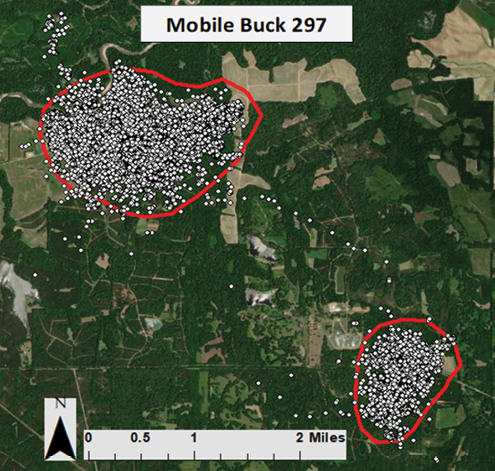
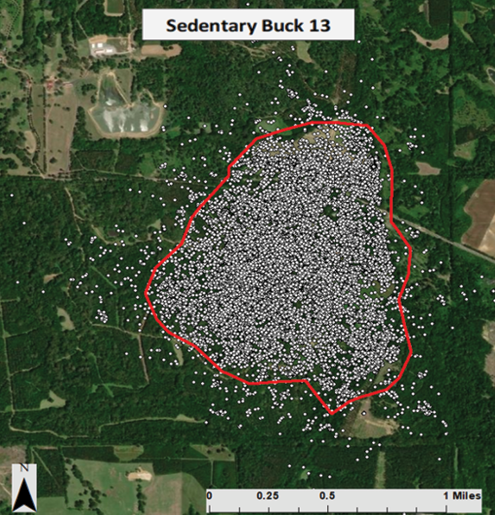
Mobile and sedentary buck home ranges differ not only in shape but also in size. Mobile buck home ranges average 12,406 acres, while sedentary bucks average 786 acres. Although the average distance between mobile buck home ranges was 4.4 miles, two bucks had home ranges separated by greater than 10 miles, and one of them traveled 18 miles and crossed the Mississippi River to get to his other home range.
When viewed as a group, mobile bucks did not transition between home range segments in a seasonal pattern. However, individual mobile bucks for which we had 2 years of consecutive data shifted between home range segments at very similar times from one year to the next. Although there was considerable variation among individuals, the average duration that mobile bucks stayed in a home range segment before traveling to the other was 79 days.
Mobile and sedentary bucks also differ in the characteristics of their excursions. Excursions are short-duration trips outside an individual’s home range, and we believe excursions are exploratory movements in search of new resources or breeding opportunities. Sedentary bucks went on an average of six excursions per year, while mobile bucks went on only one. However, mobile buck excursions lasted an average of 15 hours and were 1.5 miles from their home range, while sedentary buck excursions lasted 12 hours and were 1 mile from their home range. Excursion timing did not differ between personalities, but excursions are clearly associated with the breeding season and early spring, as very few excursions took place during summer and early fall (Figure 19). We believe that excursions in December to February are in search of breeding opportunities, and that March excursions are in search of new forage and cover resources during spring green-up. In late spring and summer, bucks don’t usually travel much as they recover from the previous rut, grow new antlers, and build body mass in preparation for the next rut.
These personalities are based on annual movements and home ranges, but we know certain factors can influence movement over a much shorter period. Deer can quickly change their movements in response to human activity, and in the next section, we describe adult buck movements during the hunting season and how they are influenced by hunting pressure.
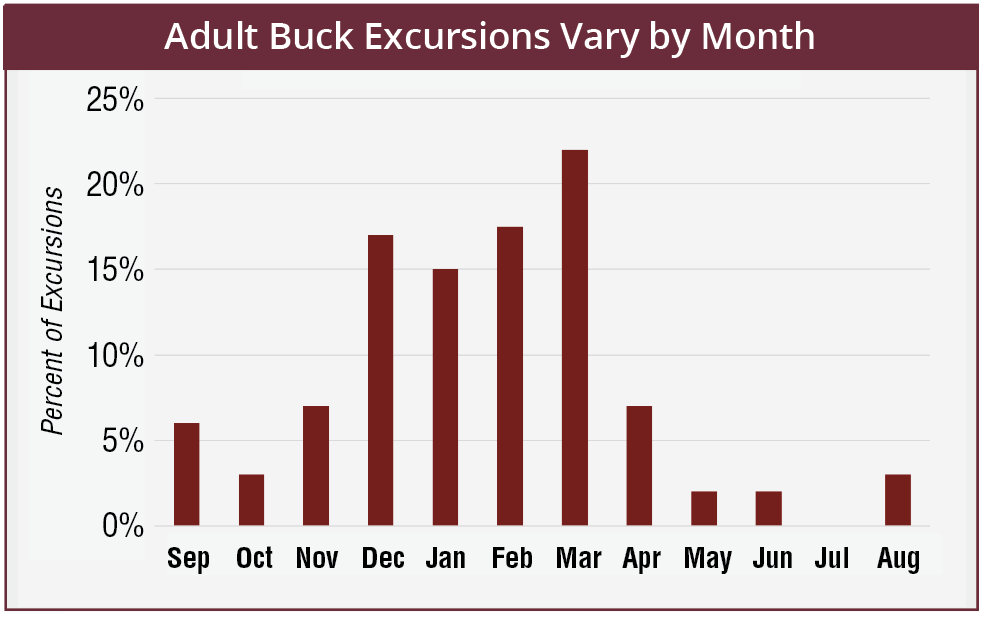
Response to Hunting Pressure
Bedding Sites during Hunting Season
Bucks used bedding areas in a variety of habitat types, including bottomland deciduous forests, pine stands, and old fields. But habitat types differ from place to place, so if you’re a hunter or a manager, you’ll want to know the physical characteristics that make bedding areas distinct and more attractive from other areas on your property. Knowing this will help you create similar features to keep deer on your property and help hunters locate them to improve their hunting success.
We compared the physical structure of the two most heavily used areas within each buck’s hunting-season home range (which were likely bedding areas) to two randomly selected areas within their home range but where they never visited. We measured screening or hiding cover based on relative visibility of a 6-by-1-foot sampling frame at a set distance from plot center (Figure 20).
Their most heavily used bedding areas had twice as much physical or structural screening cover than unused areas (Figure 21). Screening cover consists of vegetation that provides refuge to hide and rest and, in the case of deer, a place to ruminate (chew their cud). In areas that adult bucks used most frequently, there was more vegetation to screen them from the sight of human and natural predators. Some of the screening cover could also have served as a source of food—and that is ideal from a management standpoint—but their main motivation during hunting season likely was to feel safe while resting.
From the perspective of the deer, cover is important, but not all cover is necessarily created equal. Even though their main motivation was physical obstruction for hiding, it’s even better if that physical screening can also provide a source of food. Our bucks’ cover consisted of twice as much herbaceous plants and twice as much thicket-forming vegetation that includes some important deer forages, so they could also grab a bite to eat as needed. Managers should plan to produce screening cover that fulfills both the hiding and foraging needs of deer.
Ensuring deer have adequate screening cover on your land is essential if you want to keep adult bucks on your property. In the absence of vegetative cover, increased hunting pressure at some point will drive deer to move to other properties where they find the perception of safety in adequate screening cover. Clearly, habitat management strategies that provide screening cover, especially consisting of desirable forages, are an important part of adult buck management programs.
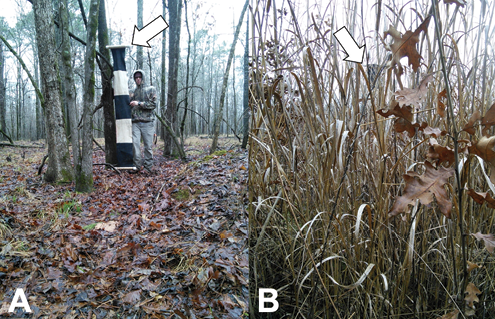

So what does this mean for deer hunters and land managers? How can we manage for structural cover that contains food?
It is advantageous for bucks to have cover and food in the same vegetation structure. Areas that our adult bucks frequented were created by common management actions that open the forest canopy, such as thinning and clear cuts. Removing canopy cover increases the sunlight reaching ground level and promotes early successional plant growth.
Once you have identified areas with the cover characteristics that adult bucks frequent, you should also know locations with food resources (i.e., nutrient patches) that bucks are likely to move toward. When moving out of these areas of very developed cover to find food, adult bucks will generally avoid navigating through areas with open understory and are more likely to choose routes that continue to provide cover. You can enhance hunting by building corridors of cover that link bedding areas to food sources.
Travel corridors are important from a hunting perspective, especially if you are an archery hunter. This is the type of area where you want to put a stand to catch a buck or any deer moving between bedding cover and nutrient patches.
Hunter Risk
For prey species (like deer), predator avoidance is critical to their survival. To that end, prey animals perceive changing levels of predation risk across their home range. Prey may change how or when they move across the landscape to minimize predation risk. Prey can also adjust the places they use based on perceived risks associated with different vegetation types.
Hunting effort is most intense during the rut and on holidays and weekends. Our study area consisted of relatively large private properties with restricted access, so overall hunting pressure was less intense than seen on some private properties and many public lands where there is little control over hunter numbers. Consequently, we would expect our documented changes in buck movement behavior in response to hunting pressure to be magnified in areas with greater hunting pressure.
Home Range Selection
Deer have adapted to avoid predation, whether natural or from humans. Deer recognize hunters as a threat and modify their behavior to minimize the threat and maximize their survival. In other words, deer have incorporated hunting/human activities into the mental map they use to navigate and assess risk in the environment. Therefore, we would expect adult bucks in our study to avoid high-risk areas, where hunters are numerous and hunter effort is most intense, and to prefer areas with relatively low levels of human activity.
We looked to see if adult bucks were changing the size and/or shape of their home ranges in response to increased risk from hunters on the landscape. The thinking behind this is that even if the bucks are not changing the size (i.e., they are using the same amount of space daily), they could be changing how complex the shape of their home range is (see Figure 22). In this case, if prey alter their behavior within their home range to mitigate risk, then traversing a larger area or having a larger home range size does not necessarily expose the animal to increased risk. Deer might respond to acute risk on the landscape by changing the size and/or complexity of their home range. More complex home ranges did not confer risk avoidance, and this pattern held for all phases of the breeding season. Also, home range size and complexity were similar across the different age classes of bucks in our study.
There are two possible reasons why adult bucks did not alter their daily home range in response to hunting. First, there was not enough hunting pressure to cause a change in home range size or complexity. It is also possible that adult bucks already have hunters figured out, and so bucks excluded hunters from their daily home range. In a system where predation risk changes over time (day of the week, month to month), animals can recognize changes in risk and react accordingly. Therefore, it is possible that bucks became more nocturnal and avoided hunters on a daily time scale that would have been difficult to measure in our analysis of home range size and complexity.

Hunter Activity
Preference for hunt locations will obviously change from hunter to hunter and with available vegetation types. Other previous research across the eastern U.S. has documented deer preferences for vegetation types, but we took it a step further and documented where hunters chose to set up stands. Hunters certainly used stands in the natural vegetation, but not nearly as often as in the modified habitats (Figure 23). Compared to selection for natural areas, hunter selection was two times greater for locations with feeders, five times greater for locations with summer food plots, and nine times greater for locations with winter food plots.
Their choice to hunt over food plots and feeders makes sense because these areas are being actively managed for the deer population and deer frequent these locations. It costs time and money to maintain food plots and supply feeders, so why would hunters make that investment and then choose to hunt in other locations? This means that areas in and around food plots and feeders would be the areas of greatest risk for deer during the hunting season. These preferences may not be surprising to hunters in the Southeast, but wait until we compare hunter preferences with the preferences of our adult bucks!
Deer selectively forage for high-quality, palatable, and easily digestible plants and plant parts. Nutrient patches are areas where high-quality forage is accessible to deer. The availability of these high-quality nutrients may vary tremendously between seasons throughout the year. For example, a soybean field may be an area of high-quality forage for deer during the growing season, but once the crop has been harvested, that now-barren field becomes a nutrition desert. We know that deer will readily consume high-quality forages when available, so it is reasonable to expect that deer will be drawn to nutrient patches for the high-quality forage opportunities they represent.

Increased Hunting Risk Changes Habitat Selection
Habitat selection is the behavioral process by which an animal “thinks like a deer” and chooses to use an area based on their recognition that the area contains the resources they seek. The habitat deer use is a subset of what is available within their home range. If deer “select for” a vegetation type, this means that these areas are used disproportionately more often given the availability. By contrast, vegetation types that deer avoid are those that are used less than expected. Because the availability of resources varies by region, the degree to which deer select particular vegetation types will differ across their range.
Deer can adjust behavior quickly, within a few days, to significant hunting activity. An MSU Deer Lab study in Oklahoma showed that deer increased their daytime use of cover by 240 percent by the second weekend of gun season. Their behavior shift produced positive effects for them—hunter observations of collared bucks known to be in the hunted areas declined 62 percent by the second weekend.
Deer selection of the natural habitats on our Mississippi study area showed a striking pattern with hunting pressure or risk. During the lowest risk days, when the fewest number of hunters were afield, the bucks were choosing upland deciduous, pine, herbaceous, and bottomland areas at greater rates than during days with higher risk. As the risk of harvest increases from low to moderate and from moderate to high, adult bucks chose these habitats less and less (Figure 24). Agricultural crop areas were also used on low-risk days but were avoided on high-risk days. These patterns suggest strongly that adult bucks minimize their use of areas with heavier hunting pressure. There is even a tipping point for hunting risk, above which adult bucks choose not to be in areas with greater risk.
Prey species, like white-tailed deer, increase survival by avoiding predators through various means, as shown by their response during our Oklahoma study. It’s reasonable that bucks minimize risks posed by hunters by decreasing their use of areas with hunters. However, our results showed bucks were selecting for food plots even on days with the highest level of risk (Figure 24), even though these were the areas where hunters also chose to be (Figure 23). These results appear confounding, but the conflict is better understood by varying the time frame of the analysis.
Our understanding of what is happening makes much more sense once we look at when bucks are using food plots and feeders (Figure 25). The adult bucks in our study were using food plots and feeders during the day, but not nearly as often as they chose to be in and around these areas at night. For example, they selected winter food plots five times more at night than during the daytime hours. Their continued use of summer food plots was also primarily at night. (Remember, many of these summer food plots contained deervetch, with a lot of standing biomass during winter. Although the deervetch is not palatable after frost, it serves as cover for some deer). So even though Figure 24 suggested that bucks selected for food plots no matter the risk level, that selection was predominantly at night to avoid the hunter risk present during the day.
Our findings show that deer are responding to an increased risk of harvest on the landscape. In other words, bucks do tend to behave in a different manner when there are more deer hunters active and hunting the land. If you want to minimize this likelihood of a change in behavior, hunters need to decrease the hunting pressure by either limiting the number of hunters on high-risk days or spreading the risk more evenly throughout the week so that deer are exposed to a lower level of risk over time. We understand that many hunters are unable to hunt during the week because of work conflicts, so decreasing the hunting pressure may not be possible for all.
We can use our results to explain and illustrate how deer may be responding to hunting pressure. State agencies often get questions from the public and especially from hunters about decreased deer sightings during the hunting season. Based on our findings, we now know with certainty that bucks are not disappearing—instead, they are changing where they are on the landscape or when they are present. Bucks in our study were able to identify where and when hunting risk was present on the landscape and change their movement behaviors accordingly to minimize their risk.


Food Plots and Feeders
Food Plot Visitation
Taking a closer look at when adult bucks chose to be in food plots, you can see the variation in visitation rates during each hour of the day (Figure 26). Adult bucks visit food plots mainly at night, with the lowest visitation rates during daylight hours. This general pattern is consistent with what we know about habitat selection by adult bucks. Adult bucks entered food plots at greater rates right around sunset, so the best opportunity for a daylight shot at these animals is by hunting them along travel corridors between daytime bedding sites and these feeding areas.

Feeder Visitation
Deer adjust their use of the landscape to take advantage of feeders and the nutrition they provide. Adult bucks visit feeders throughout the day and night; however, the frequency of visits is not consistent. Two-thirds of their visits to feeders take place between 6 p.m. and 6 a.m. (Figure 27). This makes sense given the behaviors that adult bucks tend to exhibit throughout the day. Fewer visits to feeders during the day is likely a consequence of the increased time adult bucks spend bedded during the day.
Hunters tend to use feeders to increase their chances of seeing and harvesting deer. Our results show that adult bucks are visiting sites with feeders during the hunting season, but they tend to visit feeders at night and right around sunrise and sunset. This may be because they associate feeders with increased hunting risk. Hunters might improve their chances of seeing an adult buck during legal hunting hours if they choose to hunt in locations between feeders and bedding sites.
During most of the hunting season, adult bucks are “thinking like a buck,” so their behaviors are focused on searching for and breeding receptive does while paying less attention to eating. However, bucks are attracted to the nutrients available in food plots and feeders, and they are also attracted to the females that congregate near them. On a per-acre basis, adult bucks are 10 times more likely to visit sites with a feeder and five times more likely to visit sites within a food plot than areas of natural vegetation types. Therefore, hunters who choose locations between areas of vegetative cover and areas of deer forage, such as food plots or feeders, may experience increased success in harvesting adult bucks.

Visits by Multiple Deer
Although adult bucks are solitary during the breeding season, there is considerable overlap among home ranges of individual adult bucks. The spatial overlap creates opportunities for locations to have simultaneous visits from multiple adult bucks. Over a 1-month period during the hunting season, multiple unique deer were more likely to interact at a feeder than a food plot or a randomly selected natural area on the landscape. Multiple unique deer were about 60 percent more likely to interact at a feeder than in a food plot, whereas they were about 300 percent more likely to interact at a feeder than a randomly selected natural area on the landscape.
These interactions between multiple unique deer are important to consider from a disease-transmission perspective. With multiple adult bucks interacting at feeders, it is distinctly possible that the use of feeders will contribute to increases in the spread and/or prevalence of diseases that are transmitted through contact with infected individuals, such as chronic wasting disease (CWD).
Final Thoughts
Reliable knowledge of animal behavior can improve the effectiveness of management and hunting strategies. It is important to keep in mind that bucks follow patterns of movement and locations throughout the hunting season. From week to week and month to month, the resources they use across the landscape are shifting. The key to being successful in managing for and harvesting adult bucks is to understand the resources that they are looking for, create those resources in as many places as possible on your property, and then hunt the travel corridors between bedding areas and those resources.
One of the most common ways for managers to increase or decrease habitat resources for deer is by manipulating vegetation. When managing for vegetative cover, controlling plant succession is critical for success. Plant succession is the natural process of change that plant communities experience over time on a site. If succession is not interrupted, shade-intolerant plants will be replaced by shade-tolerant plants. Interrupting plant succession allows more sunlight to reach the forest floor, resulting in greater amounts of herbaceous vegetation in the forest understory that deer can use for cover and forage.
What do our results on movement of adult bucks mean for hunters?
- Adult bucks are more susceptible to mortality events, including harvest by hunters, during periods of increased movement. The best chance to harvest an adult buck is when they move the most, so hunting during the early and peak rut phases is your best bet.
- Different personalities displayed by adult bucks can help hunters understand why some patterned bucks seem to disappear. Hunters should attempt to pattern several to increase the chance that one or more has a sedentary personality, as these are more likely to be present throughout the hunting season.
- Some bucks have a “mobile” personality, which means their home range shifts before or during deer season. Take note of when a buck starts using your property because, next year, he will likely be on your property about the same date.
- Adult bucks use many more bedding sites than you might have thought. Managers can manipulate vegetation to produce bedding sites that contain hiding cover that is also potential forage. Hunters should scout their land to locate potential bedding sites, which can inform hunting site selection across your property.
- Rather than hunting directly over food (like a food plot), consider hunting along travel corridors between vegetative cover and foraging areas to increase observation rates of adult bucks during legal hunting hours.
- Enjoy your hunt whenever you have time to be afield. Don’t worry about moon phase when planning days to hunt, as our results show no effect. However, to maximize observation rate of mature bucks, make sure you plan time in the woods during peak rut.
Buck Movement Study
More information on buck movement is available in our Buck Movement Study series on YouTube!
- Used versus Unused Bottomland Deciduous Sites
- Used versus Unused Upland Pine Sites
- Applying Research to Hunting Strategy
- Do Bucks Bed in the Same Area Every Night?
The information given here is for educational purposes only. References to commercial products, trade names, or suppliers are made with the understanding that no endorsement is implied and that no discrimination against other products or suppliers is intended.
Publication 3927 (POD-11-23)
By Bronson Strickland, PhD, St. John Family Professor of Wildlife Management, Extension Wildlife Specialist; Steve Demarais, PhD, Professor and Taylor Endowed Chair; Rebecca Cain, Research Associate; Ashley Chance, Graduate Student; Colby Henderson, Graduate Student; Garrett Street, PhD, Associate Professor; Luke Resop, Graduate Student; and William McKinley, Deer Program Coordinator, Mississippi Department of Wildlife, Fisheries, and Parks.
The Mississippi State University Extension Service is working to ensure all web content is accessible to all users. If you need assistance accessing any of our content, please email the webteam or call 662-325-2262.




